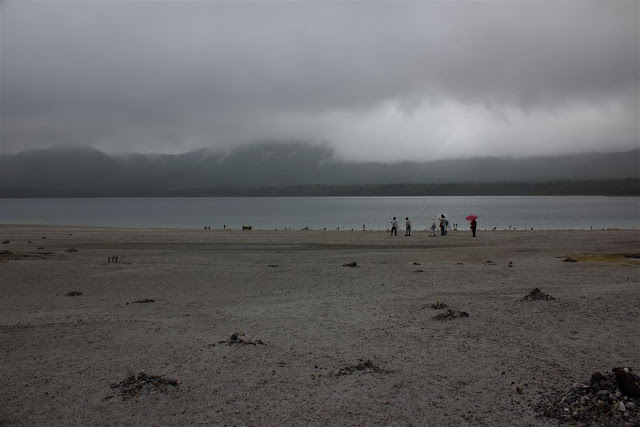На этот раз мы едем к горе Осоре, это место является одним из трех самых священных мест в Японии. Осорезан (гора Осоре) переводится с японского как "Гора Страха".
The shrine was founded over 1200 years ago by a Japanese Buddhist priest En'nin, who was at the time was studying Buddhism in China. One night he had a dream that a holy monk told him to find a sacred mountain in thirty-day walking distance from Kyoto, carve a statue of boddhisatva Jizoo and propagate Buddhism in the local area. After a long journey on foot, En'nin finally found the place up at the north of the country.
This place is very symbolic. The lake in the middle with eight peaks surrounding it represent a lotus with eight petals, which is also a symbol of the world of Buddha. 108 ponds with boiling mud (hot springs) symbolize the 108 worldly desires. All together, the forest around the lake, the white sand on the lake's shore, the hot springs, represent a beautiful scenery which suggests the beauty of the paradise.
According to the local traditions, everyone must come at least twice to this place. The first time, the tourist gets the local spirit and takes it home once he/she leaves. When the tourist comes the second time, the tourist brings the spirit back, and when the tourist comes here the third time, he/she is asking how the spirit is doing
Эта святыня была основана свыше 1200 лет назад японским Буддистским священником Эн'нином, который в то время изучал Буддизм в Китае. Однажды ночью ему явился святой монах во сне и сказал священнику найти священную гору в тридцати днях ходьбы от Киото, сделать там статую божества Джизоо, и начать проповедовать Буддизм в прилегающей территории. После долгих странствий пешком по территории Японии, Эн`нин наконец нашел гору, про которую ему рассказал монах во сне, на севере страны.
Это место чрезвычайно символично. В центре священного места расположено озеро Усори. Вокруг озера находятся восемь вершин, и это вместе символизирует цветок лотоса с восемью лепестками, что в свою очередь символизирует мир Будды. 108 прудов с кипящей грязью (горячие источники) символизируют 108 страстей. А все вместе, лес вокруг озера, полоса белого песка на берегу, горячие источники, представляет собой красивый пейзаж, что символизирует красоту рая.
Согласно местным традициям, в это место надо приезжать как минимум два раза. В первый приезд, в туриста вселяется дух этого места, и он/она увозит духа с собой. Во второй приезд, турист возвращает духа обратно.
This place is really different even from its closest surroundings. In order to get here, tourists drive through the forest with tall trees, but once they go down to the lake by the sacred place, there are hardly any trees around and the actual shrine place looks like a stone desert. The ground has a natural orange and yellow tint to it. Another big difference is in the air: the smell of sulfur is very strong here. To top things off, there are warnings everywhere to watch out for poisonous snakes.
Место святыни в корне отличается даже от ближайших окрестностей. Чтоб сюда добраться. надо ехать через леса с кронами деревьев закрывающими солнце. Добравшись, понимаешь что нет не только деревьев, но и даже земли не видно, потому что все покрыто камнями. Еще на подъезде к храму в воздухе появляется сильных запах серы. Грунт здесь натурально желто-оранжевого цвета из-за выделений серы. Ну и для полноты ощущений здесь везде расставлены знаки чтобы туристы смотрели под ноги, иногда встречаются ядовитые змеи.
Man-made stone hills are everywhere here.
Холмы из камней здесь повсюду.
As well as the statues of Buddha and boddhisatvas.
А также статуи Будды и других божеств.
And now a couple of words about why this place is called "Gateway to Hell." The first reason is that the sulfur smell is very strong here. The other reason is that the Japanese Buddhists believe that when a person dies, he/she has to cross the Sanzu River. Before he/she can cross, they meet two demons, one of which strips out the person's clothes, and the other one hangs them on the tree. The weight of the clothes determines whether the person was good or bad. Then the person has to cross the river. If the person was good during his/her life, he/she can cross the river using the bridge. You can see the bridge and the statues of demons on the picture on the believed location nearby the Mount Osore shrine.
А сейчас пояснение почему это место называется "Ворота в Ад". Во-первых, здесь очень сильный запах серы. Во-вторых, Буддисты Японии верят в то, что когда человек умирает, ему надо пересечь реку Санзу. До того, как пересечь реку, человеку встречаются два демона. Они снимают одежду с человека и вешают ее на ветку дерева. По отклонению ветки определяется вел ли человек праведный образ жизни. Если вел, тогда человек может пересечь реку по мосту. На фотографии видно статуи изображающие демонов, а также мост, который, как полагают Буддисты, находится возле храма на горе Осоре.

















No comments:
Post a Comment